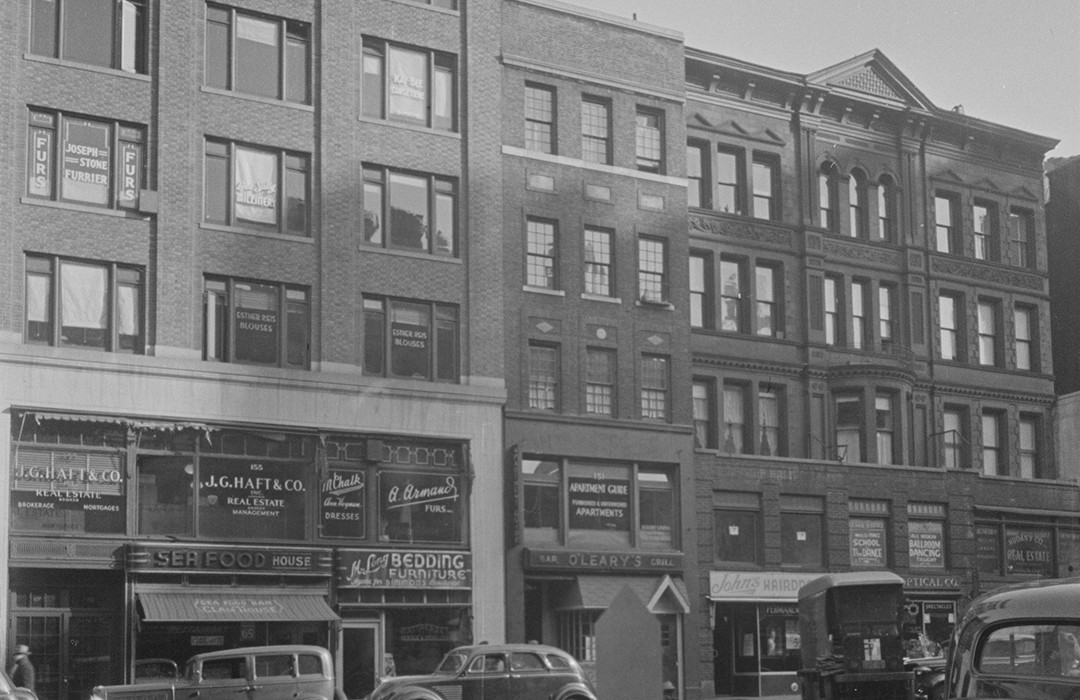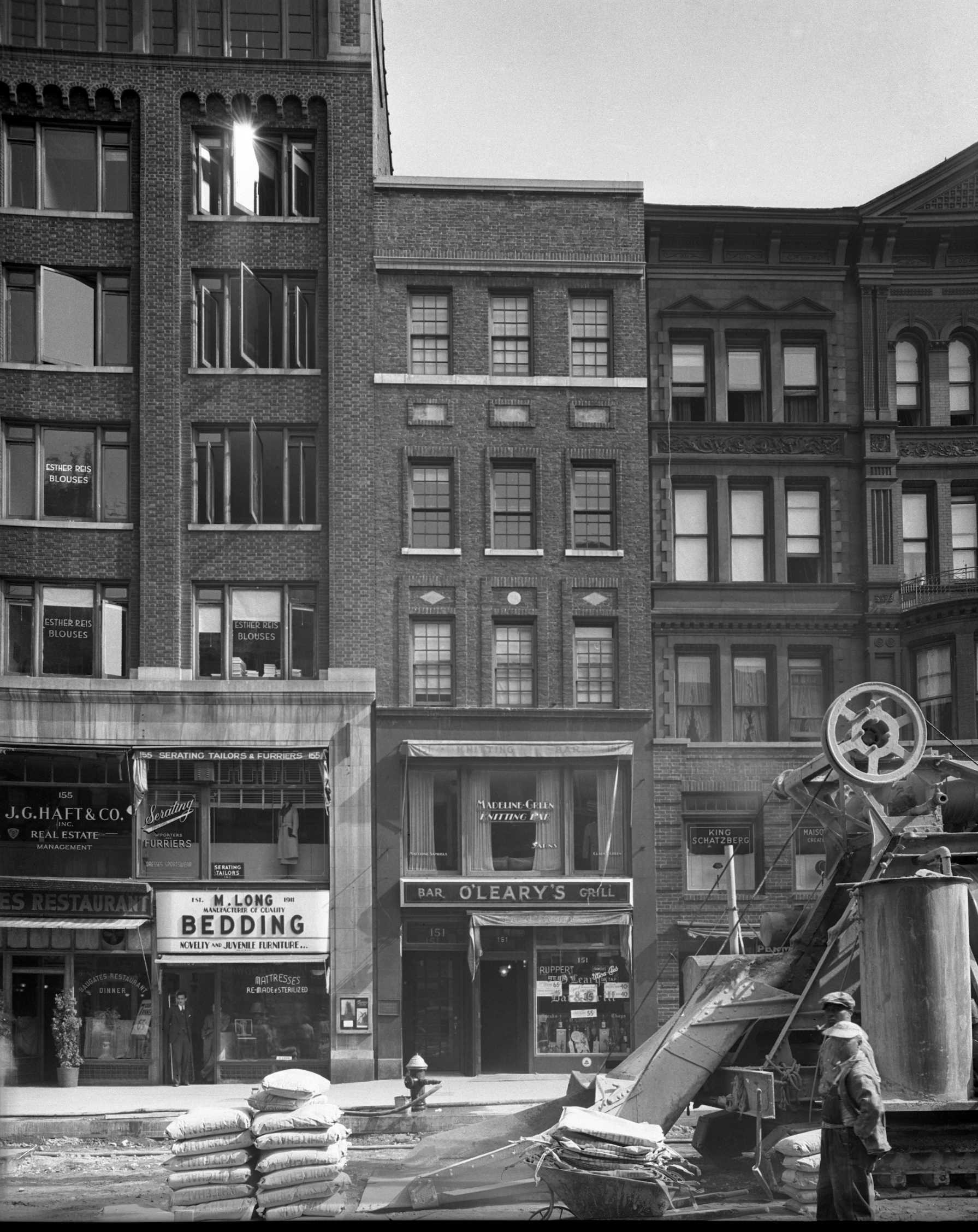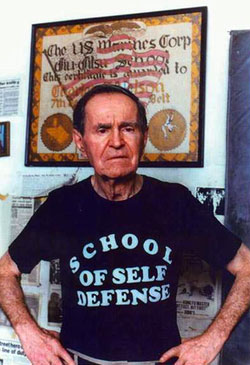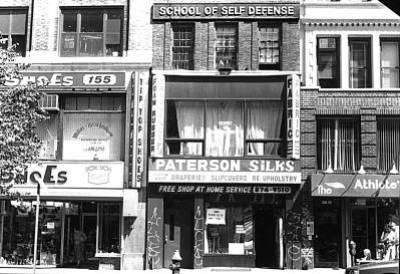
View of 151 West 72nd Street from north. Courtesy NYC Municipal Archive LINK
A Second Round for the Boathouse Lounge
by Tom Miller
In 1890 wealthy real estate developer John Symonds Radway lived in the four-story, high stooped house at 151 West 72nd Street. In the first decade of the 20th century, it was home to the well-respected physician, Dr. John Alfred Bodine. But by 1915 the Bodine family had left, prompted by change along the formerly exclusive residential block. That year the residence was being operated as a boarding house for musicians. Among the residents were voice coach Walter L. Bogert, and Madame Matja Niesseh-Stone, who formerly sang with the Boston and the Metropolitan Opera houses.
And then, on August 17, 1921, the New York Herald announced, “Redstone Realty Company will build a six story [apartment] house with small suites and store…to cost $35,000, at 151 West Seventy-second street, from plans by Greenberg & Leuchstag, architects.” The old Radway residence was demolished, and the new building commenced, the construction costs of which would translate to about $500,000 today.
Completed in 1923, the new building was designed in what is sometimes called the “Early 20th Century Commercial” style. In fact, it drew heavily from the waning Arts & Crafts style, which had been rabidly popular half a decade earlier. Above a two-story commercial front were three floors of rough, brown brick trimmed in stone. The nine-over-nine paned windows harkened to Colonial Revival, but the inset stone diamonds and rondel patterns were pure Arts & Crafts. Rather than a cornice, the architects gave the edifice a tall, blank parapet.
The second-floor space became home to the Joy-Dell Real Estate office, while the ground floor housed the Belleclaire Photographic Studio. The occupants of the apartments were middle-class, like Arthur Means, one of the initial tenants.
“Carrion said he was a mere visitor in the house, and really wouldn’t know whether tons of gold bullion were concealed in the place.”
In 1927 Means was an organizer of the Metropolitan Sweepstakes car race at the Metropolitan Heights Fair Grounds at Maspeth, Queens. It took place on Sunday, September 16, but things did not go entirely smoothly. The Brooklyn newspaper The Chat began an article saying, “Two near fatalities gave added thrills to the automobile races run last Sunday.” Then, after detailing the accident and the winners of the race, the article added, “On a charge of violating the Sabbath law, three men connected with the management of the race track were before Magistrate Doyle in Ridgewood Court Monday.”
Dalton LaRose entertained three guests in his apartment on Sunday night, April 22, 1929. At around 3:00 in the morning LaRose “escorted two guests to their home a short distance from his place [while] Ralph Carrion, who has the top floor apartment, guarded the LaRose suite,” according to the Brooklyn newspaper the Times Union.
While Carrion waited for LaRose to return, two men entered the apartment, each holding a revolver. They demanded to know where the money was. The Times Union reported, “Carrion said he was a mere visitor in the house, and really wouldn’t know whether tons of gold bullion were concealed in the place.” The thieves found $9 hidden in the phonograph and then ordered Carrion to turn over the $3 he had on him.
As the drama played out, LaRose returned him. The intruders had not closed the door entirely and he could see what was happening through the gap. He quietly slipped back down the stairs and found Patrolman Americk Terreri. The officer waited on the sidewalk for the robbers to exit. Taking no chances, said the newspaper, Terreri “brought his locust down upon a skull. The fellow dropped. Now, robbers are averse to this sort of treatment, so the second bandit dropped his gun, threw up his hands and begged to be spared the fate of his chum.” They both pleaded guilty to armed robbery.
At the time of the attempted theft, the ground floor was home to a nightclub, the Boat Lounge. Of course, Prohibition was in full force in 1929, so the patrons had to do without cocktails. Or that’s what the managers would want Federal agents to think.
On August 2, 1929, the Times Union reported that “A dozen raids, as many arrests for possession and seizure of quantities of whiskey and gin were the features early today and last night of continuance by Inspector McCormick’s staff of detectives of the drive on liquor retailers…A large cutting plant in West 72d st. was among those seized.”
A “cutting plant” was an operation that diluted bootleg liquor to drinkable strength. The article said, “The entered 151 West 72d st. shortly before midnight, where they found a large assortment of apparatus used in thinning the liquors vended to the city’s thirsty and seized 480 bottles of gin, rye, Scotch and liquors that had been properly cut.” Joseph Riley was arrested. “He had nothing to say to the raiders,” said the article.
The proprietors of the nightclub did not learn their lesson. The following year, on December 12, 1930 The New York Evening Post reported that Prohibition agents had raided 151 West 72nd Street, “a place known as the ‘Boat Lounge,’ where James DeMarte was arrested and eleven bottles of liquor seized.”
The proprietors of the nightclub did not learn their lesson.
In an unintentional and ironic play on words given the previous occupant of the ground floor space, in 1936 it was home to The Knitting Bar. It supplied crafts enthusiasts with all the supplies necessary for their knitting hobby.
The second story still housed a real estate office, now operated by the S. H. Riesner Co., Inc.
Prohibition was repealed in 1933 and six years later William O’Leary got a liquor license for O’Leary’s Irish tavern on the ground floor. The pub would remain in the space for several years.
After having been a real estate office for decades, around 1982 former Marine Charles “Charlie” Nelson opened the Nelson’s School of Self-Defense in the second-floor space. On February 8, 1982 New York Magazine said, “He insists that students learn when to fight and when to yield; if they do fight, he advocates hurting the assailant before applying a choke, hold or even a throw.” Nelson ran his school here until 1993.
In 1999 the upper floors were renovated to two apartments per floor on the third and fourth, and a duplex in the fifth and new penthouse level, unseen from the street. The ground floor space had been home to Paterson Silks for about six years at the time. The fabric store was still there in 2000. Today it is home to the boutique Variazioni.
Tom Miller is a social historian and blogger at daytoninmanhattan.blogspot.com
LEARN MORE ABOUT
151 West 72nd Street
Next Stop
Be a part of history!
Shop local to support the businesses currently at 151 West 72nd Street:





